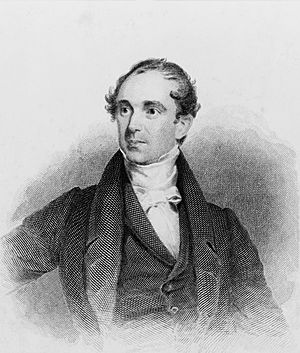Henry D. Gilpin facts for kids
Quick facts for kids
Henry D. Gilpin
|
|
|---|---|
 |
|
| 14th United States Attorney General | |
| In office January 11, 1840 – March 4, 1841 |
|
| President | Martin Van Buren |
| Preceded by | Felix Grundy |
| Succeeded by | John J. Crittenden |
| 2nd Solicitor of the United States Treasury | |
| In office June 16, 1837 – January 11, 1840 |
|
| Preceded by | Virgil Maxcy |
| Succeeded by | Matthew Birchard |
| U.S. Attorney for the Eastern District of Pennsylvania | |
| In office 1831–1837 |
|
| Personal details | |
| Born |
Henry Dilworth Gilpin
April 14, 1801 Lancaster, Lancashire, UK |
| Died | January 29, 1860 (aged 58) Philadelphia, Pennsylvania, U.S. |
| Resting place | Laurel Hill Cemetery, Philadelphia, Pennsylvania, U.S. |
| Political party | Democratic |
| Education | University of Pennsylvania (BA) |
| Signature | |
Henry Dilworth Gilpin (born April 14, 1801 – died January 29, 1860) was an important American lawyer and government official. He served as the 14th Attorney General of the United States under President Martin Van Buren from 1840 to 1841. Before that, he was the 2nd Solicitor of the United States Treasury from 1837 to 1840. He also worked as a U.S. Attorney for the United States District Court for the Eastern District of Pennsylvania from 1831 to 1837.
Contents
Early Life and Education
Henry Gilpin was born in Lancaster, England. His parents were Joshua Gilpin, an industrialist from Philadelphia, and Mary Dilworth. Henry was born just before his family moved back to America.
His father, Joshua, had been traveling in Britain and Europe. He was learning about new ways to make paper for his family's paper mills. These mills were located on Brandywine Creek in Delaware.
In 1812, Henry's family returned to England for another visit. Henry went to school near London during this time. Around 1816, he came back to the United States. He later graduated from the University of Pennsylvania in 1819. After college, he studied law with Joseph R. Ingersoll and became a lawyer in 1822.
Public Service and Career
Henry Gilpin began his career in public service. From 1831 to 1837, he served as the U.S. Attorney for the Eastern District of Pennsylvania. This role meant he represented the U.S. government in legal cases in that area.
After that, in 1837, he became the Solicitor of the United States Treasury. This job involved handling legal matters for the U.S. Treasury Department. During these years, he also joined the American Philosophical Society in 1832.
Working with the Bank of the United States
From 1833 to 1835, Gilpin was part of the board of the Bank of the United States. This bank was very powerful at the time. President Andrew Jackson believed the bank had too much control.
Gilpin agreed with President Jackson. He worked to make sure the bank's special permission to operate was not renewed. Because of these efforts, the bank closed down in 1836. In 1835, President Jackson wanted Gilpin to be the governor of Michigan. However, Jackson's political opponents in Congress stopped this from happening.
Serving as Attorney General
In 1840, President Martin Van Buren chose Henry Gilpin to be the 14th Attorney General of the United States. This is the chief lawyer for the U.S. government. He held this important position until 1841.
During his time as Attorney General, Gilpin worked on a famous case. He presented the U.S. government's arguments in the Amistad case. This case was heard by the U.S. Supreme Court.
Other Important Roles
After his time as Attorney General, Gilpin continued to be active in public life. From 1852 to 1859, he was the president of the Pennsylvania Academy of the Fine Arts. This is a famous art school and museum.
He also served as a vice president and trustee for the Historical Society of Pennsylvania. He was an associate member of the Massachusetts Historical Society. Gilpin was a director of Girard College from 1856 to 1858. He also served as a trustee for the University of Pennsylvania.
Gilpin also worked as the secretary for the Chesapeake & Delaware Canal. This canal was an important waterway for trade and travel.

His work with the Chesapeake and Delaware Canal allowed him to travel widely. He explored many parts of the Eastern United States. His travel writings were later put into a seven-volume book by his father. The book was called Atlantic Souvenirs (1826-1832).
Gilpin also wrote articles about politics and literature. These articles appeared in various newspapers and journals. Some of these included the American Quarterly and the Democratic Review. He also wrote about famous politicians like Henry Clay and Daniel Webster.
Henry Gilpin passed away in Philadelphia in 1860. He was buried at Laurel Hill Cemetery.
Legacy
Henry D. Gilpin left a lasting legacy. Through his will, he created the Henry D. Gilpin Fund. This fund was established for the Chicago Historical Society. Its purpose was to help create the Gilpin library.
See also
 In Spanish: Henry D. Gilpin para niños
In Spanish: Henry D. Gilpin para niños

